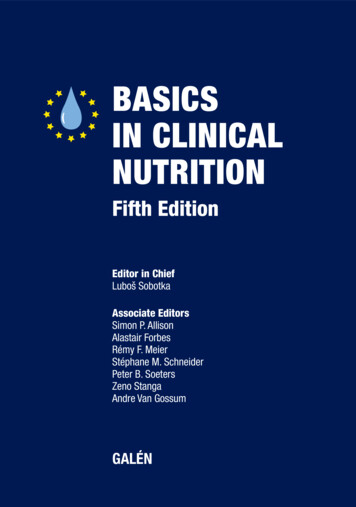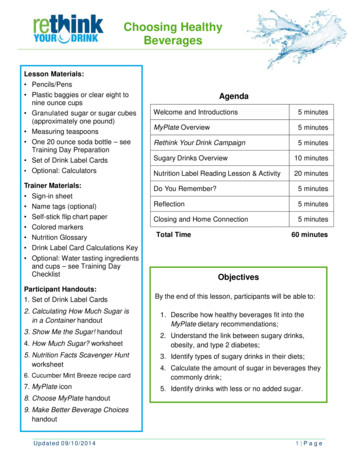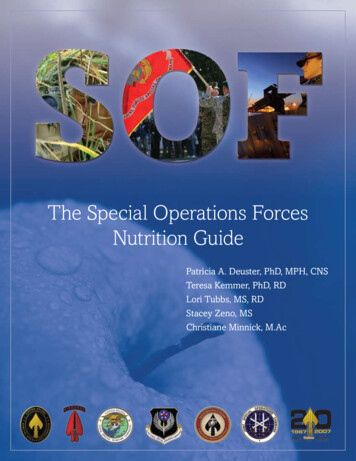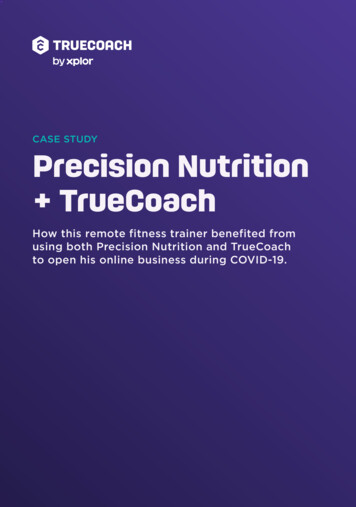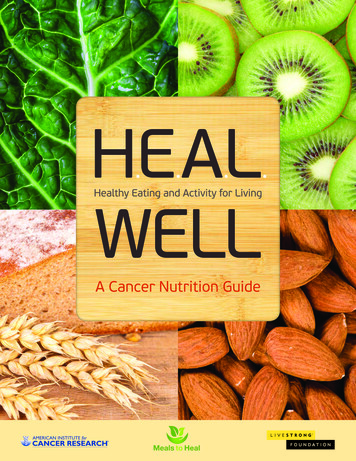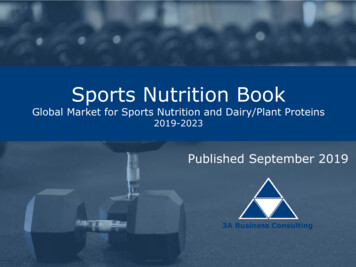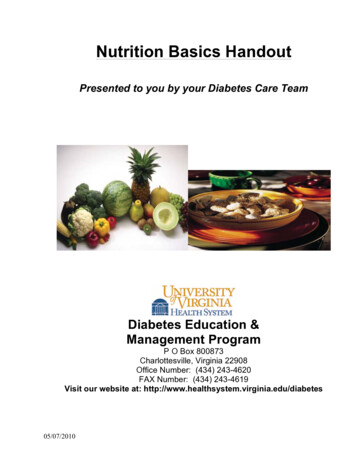
Transcription
Nutrition Basics HandoutPresented to you by your Diabetes Care TeamDiabetes Education &Management ProgramP O Box 800873Charlottesville, Virginia 22908Office Number: (434) 243-4620FAX Number: (434) 243-4619Visit our website at: /2010
Class Objectives: Participants will learn how to make healthy food choiceso what to eat, when to eat, and how much to eatParticipants will gain an understanding of how different nutrients effect their bloodglucose levelsParticipants will be introduced to meal planning approacheso The Plate Method and Carbohydrate CountingParticipants will understand how to make heart healthy food choicesBasic Healthy Eating Principles- Eat a Variety of Foods All foods can fit into a healthy diabetes eating planChoices more whole grains, beans, vegetables, and fruitsUse less fat, sugar, and saltEat well-balanced meals with carbohydrate, protein, and a small amount ofhealthy fat- When to Eat Spread meals out over the entire dayAll foods can fit into a healthy diabetes eating planEat at consistent times each dayAvoid eating one or two large mealsDo not skip mealsWork snacks into your meal plan, if needed- How Much to Eat Try to eat the same amount of food at each meal Plan meals to include similar amounts of carbohydrateo 3-5 carbohydrate choices/meal Be aware of portion sizes!1
Two Types of Carbohydrates (simple and complex) Simple Carbohydrates Sugarso Natural Sugars! Fruit and Fruit Juice (fructose or fruit sugar)! Milk and Yogurt (lactose or milk sugar)o Added Sugars! Table sugar (sucrose)! Honey! High Fructose Corn Syrup! Sweets and desserts made with sugar - regular soda, jello, candy, cake,cookies, pie Complex Carbohydrates Starcheso Breads, cereals and grains, pasta, starchy vegetables, crackers, beans, peas,lentilso Complex Carbohydrates are a major source of dietary fiber Dietary fiber is not completely digested and absorbed like other carbohydratesInsoluble fiber - constipation, cancer risk, heart diseaseSoluble fiber - blood fat levels and improve glucose controlThe goal is to consume 25-35 grams of fiber per day.Sources of FiberSoluble Fiber ( to help lowerblood fats and blood glucose)OatsOat branOatmealBarleyDriedpeas2Rice branCorn branKidney beansPinto beansBlack beansFresh fruitInsoluble Fiber (to helpprevent constipation anddisease risk)Whole grainsWhole-grain products:Bread, cereal, crackersBrown rice and pastaRaw VegetablesFresh fruit
Serving Sizes for Carbohydrate FoodsEvery Serving of Carbohydrate 15 grams ofCarbohydrateServing Sizes for Grains, Beans and StarchyVegetables (15 g carb): 1 slice of bread, ½ a hot dog or hamburgerbun, 1 oz bagel or English muffin 1 small potato – 3 oz 1/3 c. cooked rice or pasta ½ c. cooked cereal, beans, or corn ¾ c. dry, unsweetened cereal (but read thelabel) ½ c. green peas ½ c. mashed potatoes or sweet potato 1 c. acorn or butternut squash 6 crackersServing Sizes for Milk (15 g of carb): 1 c. low-fat or non-fat milk 6-8 ounce yogurt with “lite” or “light” onthe labelAdditional Carbohydrates (15g ofcarbohydrate): It is best to look at the label! 2 small cookies ½ cup ice cream (regular, light, or fatfree, no sugar) ¼ cup of sherbet ½ cup of sugar free pudding 2 inch brownie square or cake with noicing 5 vanilla wafers, 3 ginger snaps 3 cups popcorn ¾ oz pretzels, potato chips Fruit juice bar 100% juice 1 TBSP jelly, jam, honey, syrup3Serving Sizes for Fruits (15 g of carb): 1 small apple – 4 to 6 oz. 1 c. fresh berries ½ c. canned fruit in its own juice orwater 1 c. cubed melon 17 grapes 1 small banana 1 medium peach or orange ½ grapefruit 12 fresh cherries 2 TBSP of raisins ¼ c. dried fruits ½ c. fruit juice – 4 oz.Serving Sizes for Non-Starchy Vegetables (5 gcarb) Do not count these in your carbohydrate plan: 1 c. raw vegetables or ½ c. cookedvegetables 3 cups raw or 1 ½ cups cooked 1carbohydrate choicePractice measuringportions until you improveyour estimation skills!
Don’t Ignore Protein and FatMeals should be balanced with adequate protein and fat.Most adults need only 6 ounces of protein a day.Large portions of protein may adversely affect your blood sugar.Meals without protein may cause your blood sugar to rise faster than desired.Include small amounts of healthy fats in your meals.A high fat meal will delay the rise of your blood sugar.Eating too much protein and fat may cause weight gain and other diabetes-relatedcomplications such as heart disease and kidney disease.Meat and Meat Substitutes to Choose: Cooked lean meat, poultry, or fish low-fat or fat-free cottage cheese 1 egg or 1 slice cheese (equals 1 oz meat) 1 Tbsp of peanut butter (equals 1 oz meat) 3 oz. of meat TofuFats and Serving Sizes (goal is 0-3 servings per meal): 2Tbsp – Avocado or Lite salad dressing 1 oz nuts (examples – 10 peanuts, 6 almonds) 1 tsp of oil, margarine, butter, or mayonnaise 1 Tbsp – Seeds, Oil, Margarine, Mayonnaise, Salad dressing 2 Tbsp half and half, sour creamFree Foods have less than 5 g of carbohydrate per serving. Be aware and avoid largeportions of these foods. Examples include: 1 Tbsp fat-free or low fat: cream cheese, salad dressing, or sour cream Sugar-free gelatin 1 piece of hard, sugar-free candy 1 Tbsp catsup or pickle relish Coffee, tea, diet soft drinks ¼ cup salsa Seasonings: garlic, fresh & dried herbs, spicesLabel Reading Tips:Be sure to look at : Serving size Total carbohydrate Sodium Total and Type of Fat4
Meal Planning Approaches: The Plate MethodThe Plate Method is a meal planning approach that promotesconsistent carbohydrate, low fat meals for blood glucose controland heart health. Below are the guidelines for following theplate method, and on the reverse is a sample plate. The PlateMethod works best when using a 9-inch plate. Carbohydrates. Your meals should include approximately 3 or 4carbohydrate choices, which is equivalent to 45 to 60 grams ofA healthy daily meal plan includes at least:2-3 servings of non-starchy vegetables2 servings of fruit6 servings of grains, beans, and starchy vegetables2 servings of low-fat or fat-free milkAbout 6 oz. of meat or meat substituteSmall amounts of fat & sugarPlate Method at Breakfastcarbohydrates. (1 carbohydrate choice equals 15 grams ofcarbohydrates) Carbohydrates are grains, legumes, fruits, starchyvegetables, and dairy. Choose whole grains over processed, refinedgrains. Vegetables. Fill half your plate with 1 cup or more of non-starchyvegetables such as lettuce, cabbage, cucumbers, peppers,Fruit1/2 banana1/2 cup juice1 cup berries2 Tbsp raisinsProtein1 egg1 oz cheese2 Tbsp peanutbuttermushrooms, onions, garlic, beets, green beans, broccoli, celery,carrots, cauliflower and tomatoes. An easy way to meet thisrequirement is to eat a small salad along with your side vegetable. Lean Protein. The protein section should provide 3 ounces of meator meat substitute, the same dimensions as a deck of cards.Examples are: poultry, fish, and lean steak. Examples of vegetariansources of protein are: beans, tofu, cheese, eggs, and peanut butter.5Starch/grain/bread2 slices whole wheat bread1 cup oatmeal1oz dry cereal1 Eng. muffin or sm. bagelMilk oryogurt1 cup
lowerGreen beansLeafy AsparagusSpinachMushroomsServing 1 cup rawor ½ cup cookedLean ProteinMEATFishChickenTurkeyPork loinLean beefSeafoodNON-MEATBeans*½ cup*Eggs1 eggPeanut Butter1 TbspTofu½ cupLow-fat Cheese 1 slice*count as onecarbohydrate serving6Sources ofCarbohydrateStarch, Fruit,&/or MilkCHOOSE 3-4serv.Non-Starchy VegetablesUNLIMITEDLean ProteinCHOOSE 2-3 oz.Oozoz1 serving of carbohydrate 15 gramsStarchesPotatoesCornDry beans ½ cupPeasMacaroniPasta1/3 esPancakesFruitsOrangePearApple1 fruitKiwiPeachBananaMango½ fruitGrapefruitBerriesGrapes1 cupPineappleCantaloupeWatermelonMilkSkim milkLow fat milk 1 cupLite yogurt
Meal Planning Approaches: Carbohydrate CountingCarbohydrate Counting emphasizes the total amount of carbohydrate not the source! Carbohydrate consistency and portion control" One carbohydrate serving 15 grams of carbohydrate" Goal for most people 3-5 carbohydrate servings/meal, which is 45 – 75 grams/mealBreakfast Examples 1 English muffin½ cup grits1 poached egg1 small bananaCoffee with SplendaHow many carbohydrateservings are in this meal?Breakfast Examples How many carbohydrateservings are in this meal?Lunch Examples 1 cup tomato soup Grilled cheese sandwich(2 slices bread, 2 slices cheese, 2 tsp. margarine) 1 cup cantaloupe cubes 1 large oatmeal-raisin cookie Tea with SplendaHow many carbohydrateservings are in this meal?Lunch Examples 1 large sweet potato (9oz)1 pork chop (4oz)½ cup collard greens1 cup fruit cocktailIced tea (unsweetened)How many carbohydrateservings are in this meal?72 slices wheat bread1 slice (1 oz) low-fat Swiss cheese1 slice turkey (1 oz.)Carrot sticks17 small grapes1 cup light yogurtDiet CokeHow many carbohydrateservings are in this meal?Dinner ExamplesDinner Examples 1 ½ cup cheerios1 cup 2% milk½ cup orange juiceCoffee with 2 Tbsp. low-fat milk 1 cup pasta1/2 cup spaghetti sauce3 meatballs2 Tbsp. parmesan cheeseGreen salad1 breadstick½ cup light ice creamWaterHow many carbohydrateservings are in this meal?
Heart Healthy EatingSources of Fat and Cholesterol:Food contains three types of fats, and some are better for you than others, dependingon how they affect your cholesterol:Unsaturated FatSaturated FatTrans FatPreferred fat sources, in small amountsLimit these fat sourcesAvoid these fat sourcesMonounsaturatedOil (olive, canola, peanut)OlivesAvocadosPeanut butterNuts (peanuts, cashews, almonds)! LDL cholesterol! HDL cholesterolPolyunsaturatedOil (Corn, Safflower, Soybean)MargarineMayonnaiseWalnutsSesame SeedsOmega fatty acids in fishMeatCheeseEgg yolkWhole milk2% milkIce creamButterBaconSour creamFatbackCoconut oilShorteningHydrogenatedvegetable oilPoultry skinPartially hydrogenatedvegetable oil(may be found invegetable shortening,some margarines,crackers, cookies,snack foods)! LDL cholesterol! HDL cholesterol! LDL cholesterol! LDL cholesterol# Remember that all fats are high in calories and, in excess, can contribute toweight gain.Ways to Limit Total and Saturated Fat:8 Choose lean meats, fish and poultry Use skim or low-fat milkLimit egg yolks to three times per weekLimit high-fat animal products such as bacon, hot dogs, cheese and butterLimit commercially prepared baked and snack foods Use monounsaturated fat for cooking and to replace other oilsLimit trans fat to as little as possible
Sodium Half of the people with diabetes also have high blood pressure Reducing dietary sodium may help reduce blood pressureSodium recommendations (American Heart Association): 1,500 mg per dayThe amount of sodium in 1/2 tsp. of salt 1,200 mgWays to Reduce Sodium in Your Diet:9 Decrease salt in cookingRemove the salt shaker from the tableEat smaller portions of high sodium foods Try seasonings and spices that can add flavor without adding sodium like Mrs.Dash Look for lightly salted or no salt addedAvoid:o Fast foodso Canned foodso Salty snackso Rice/noodle mixes and boxed meals Choose pre-packaged foods that are:o Less than 400 mg per serving for snacks and side disheso Less than 800 mg per serving per entrée
CHO0SING SNACKSChoose one from each circle for a healthy, satisfying snack.CARBOHYDRATESGrains1 oz bagel½ English muffin20 pretzels sticks2 4-in. rice cakes6 crackers12-15 veggie chips½ whole wheat pita¼ cup low-fat granola2 slices reduced calorie bread1 whole wheat tortilla (6 in.)3 graham cracker squares3 cups light popcornFruits1 ¼ cup whole strawberries¾ cup blackberries or blueberries1 cup cantaloupe or honeydew1 ¼ cup watermelon1 small apple or pear½ cup cherries1 medium peach2 tbsp. raisins17 grapesDairy8 oz. low fat or fat-free milk 6-8 oz. lite yogurt½ cup ice cream½ cup sf pudding10PROTEINMeats1-2 oz. white meat,skinless, chicken, turkey1 hard boiled egg½ cup egg whites1-2 oz. deli meat1-2 oz. turkey/tuna/egg saladmade with light or fat-free mayo1-2 oz. salmonCheese1 oz. part-skim block cheese, soy cheeseor string cheese¼ cup part-skim grated cheese¼ cup low fat or fat -free cottage cheese2 tbsp fat-free cream cheeseBeans & Dip1/3 cup hummus½ cup tofu1/3 cup bean dip¼ - ½ cup edamame1 oz soynutsNuts & Seeds1 oz. sunflower, pumpkin,or sesame seeds1 oz. pecans, walnuts, almonds,cashews, or peanuts1 oz. peanut, almond, orcashew butter
NOTES:Thank you for attending “Nutrition Basics”.11
Basic Healthy Eating Principles - Eat a Variety of Foods All foods can fit into a healthy diabetes eating plan Choices more whole grains, beans, vegetables, and fruits Use less fat, sugar, and salt Eat well-balanced meals with car

